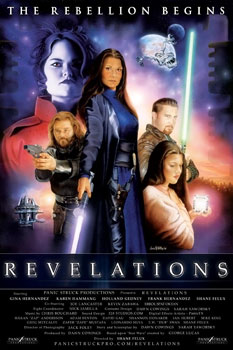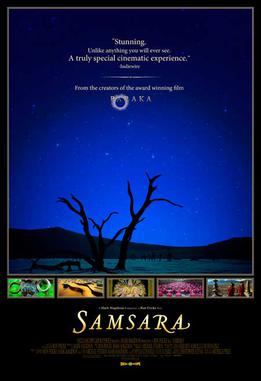
Return of the Jedi is a 1983 American epic space opera film that is the sequel to Star Wars (1977) and The Empire Strikes Back (1980). It is the third installment in the original Star Wars trilogy and the sixth chronological film in the "Skywalker Saga". It is directed by Richard Marquand based on a screenplay by Lawrence Kasdan and George Lucas from a story by Lucas, who was also the executive producer. The film follows the ongoing struggle between the malevolent Galactic Empire and the freedom fighters of the Rebel Alliance. As the Rebels attempt to destroy the Empire's second Death Star, Luke Skywalker hopes to bring his father, Darth Vader, back from the dark side of the Force. The film stars Mark Hamill, Harrison Ford, Carrie Fisher, Billy Dee Williams, Anthony Daniels, David Prowse, Kenny Baker, Peter Mayhew and Frank Oz.

Star Wars: Episode III – Revenge of the Sith is a 2005 American epic space opera film that is the sequel to The Phantom Menace (1999) and Attack of the Clones (2002). It is the sixth film in the Star Wars film series, the third installment in the Star Wars prequel trilogy, and third chronological chapter of the "Skywalker Saga". It is written and directed by George Lucas, who also served as executive producer. The film stars Ewan McGregor, Natalie Portman, Hayden Christensen, Ian McDiarmid, Samuel L. Jackson, Christopher Lee, Anthony Daniels, Kenny Baker, and Frank Oz.

Naqoyqatsi is a 2002 American non-narrative film directed by Godfrey Reggio and edited by Jon Kane, with music composed by Philip Glass. It is the third and final installment in the Qatsi trilogy.

Baraka is a 1992 American non-narrative documentary film directed by Ron Fricke. The film is often compared to Koyaanisqatsi, the first of the Qatsi films by Godfrey Reggio for which Fricke served as cinematographer. It was photographed in the 70 mm Todd-AO format, and is the first film ever to be restored and scanned at 8K resolution.

The Clone Wars is a fictional conflict in the Star Wars franchise by George Lucas. Though mentioned briefly in the first Star Wars film, the war itself was not depicted until Attack of the Clones (2002) and Revenge of the Sith (2005). The Clone Wars are also the setting for three eponymous projects: a 2D animated series (2003–2005), a 3D film (2008), and a 3D animated series. They have featured in numerous Star Wars books and games.

Chronos is a 1985 abstract film directed by Ron Fricke, created with custom-built time-lapse cameras. Originally released in IMAX theaters, it is now available on DVD, Blu-ray and HD DVD.

Time-lapse photography is a technique in which the frequency at which film frames are captured is much lower than the frequency used to view the sequence. When played at normal speed, time appears to be moving faster and thus lapsing. For example, an image of a scene may be captured at 1 frame per second but then played back at 30 frames per second; the result is an apparent 30 times speed increase. Similarly, film can also be played at a much lower rate than at which it was captured, which slows down an otherwise fast action, as in slow motion or high-speed photography.

The Qatsi Trilogy is a series of three non-narrative films produced by Godfrey Reggio and scored by Philip Glass. The trilogy includes Koyaanisqatsi (1982), Powaqqatsi (1988), and Naqoyqatsi (2002).

Star Wars: Revelations is a fan film released on April 17, 2005, created by fans of George Lucas's Star Warssaga. The film takes place between Revenge of the Sith and A New Hope, and explains why the Jedi Order was extinct in the original trilogy.

Star Wars: Episode III – Revenge of the Sith is an action video game based on the movie of the same name. It was released on May 5, 2005, for the PlayStation 2, Xbox, Game Boy Advance, Nintendo DS, and Symbian OS. For the Xbox 360's backwards compatible lineup, Revenge of the Sith is one out of the 400+ backwards compatible games for the 360. As part of the PlayStation 2 classics program, the PlayStation 2 version was re-released in Europe on the PlayStation Network on February 11, 2015, and in North America on April 28, 2015. Meanwhile, the Xbox version was also added to the backwards compatibility list for the Xbox One and Xbox Series X/S on November 15, 2021.
The Star Wars prequel trilogy, colloquially referred to as the prequels, is a series of epic space-opera films written and directed by George Lucas. It was produced by Lucasfilm Ltd. and distributed by 20th Century Fox. The trilogy was released from 1999 to 2005 and is set before the original Star Wars trilogy (1977–1983), chronologically making it the first act of the Skywalker Saga. Lucas had planned a prequel trilogy before the release of the original film, but halted major Star Wars films beyond the original trilogy by 1981. When computer-generated imagery (CGI) had advanced to the level he wanted for the visual effects he wanted for subsequent films, Lucas revived plans for the prequels by the early 1990s. The trilogy marked Lucas's return to directing after a 22-year hiatus following the original Star Wars film in 1977, as well as a 16-year hiatus between the classic and prequel trilogies.

Dennis Muren, A.S.C is an American film visual effects artist and supervisor. He has worked on the films of George Lucas, Steven Spielberg, and James Cameron, among others, and has won nine Oscars in total: eight for Best Visual Effects and a Technical Achievement Academy Award. The Visual Effects Society has called him "a perpetual student, teacher, innovator, and mentor."

Samsara is a 2011 American non-narrative documentary film of international imagery directed by Ron Fricke and produced by Mark Magidson, who also collaborated on Baraka (1992), a film of a similar vein, and Chronos (1985).
Roger Barton is an American film editor. He has worked on dozens of Hollywood films, including Titanic, Armageddon, Pirates of the Caribbean: Dead Men Tell No Tales, and Star Wars: Episode III – Revenge of the Sith.

Harris Savides was an American cinematographer. Nominated for a BAFTA Award and five Independent Spirit Award, he is most known for his collaborations with director Gus Van Sant including Finding Forrester (2000), Gerry (2002), Elephant (2003), Last Days (2005), Milk (2008), and Restless (2011).
Michael Stearns is an American musician and composer of ambient music. He is also known as a film composer, sound designer and soundtrack producer for large format films, theatrical films, documentaries, commercials, and themed attractions.

Ellen Kuras is an American cinematographer whose work includes narrative and documentary films, music videos and commercials in both the studio and independent worlds. One of few female members of the American Society of Cinematographers, she is a pioneer best known for her work in Eternal Sunshine of the Spotless Mind (2004). She has collaborated with directors such as Michel Gondry, Spike Lee, Sam Mendes, Jim Jarmusch, Rebecca Miller, Martin Scorsese and more. She is the three-time winner of the Award for Excellence in Dramatic Cinematography at the Sundance Film Festival, for her films Personal Velocity: Three Portraits, Angela and Swoon, which was her first dramatic feature after getting her start in political documentaries.

Sheev Palpatine is a fictional character in the Star Wars franchise created by George Lucas. He first appears on screen in The Empire Strikes Back (1980), in which he is credited as The Emperor, and is the overarching antagonist of the three film trilogies in the Skywalker Saga, in which he is portrayed by Ian McDiarmid. The character is also known by his Sith name, Darth Sidious, which was first used in the novelization of The Phantom Menace (1999). In creating Palpatine, Lucas was inspired by real-world examples of democratic backsliding during the rise and rule of dictators such as Julius Caesar, Napoleon Bonaparte, and Adolf Hitler.

Koyaanisqatsi is a 1982 American non-narrative documentary film directed and produced by Godfrey Reggio, featuring music composed by Philip Glass and cinematography by Ron Fricke.
Non-narrative film is an aesthetic of cinematic film that does not narrate, or relate "an event, whether real or imaginary". It is usually a form of art film or experimental film, not made for mass entertainment.















